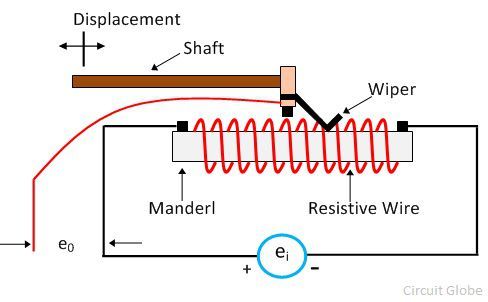Definition: The instrument designs for measuring the unknown voltage by comparing it with the known voltage, such type of instrument is known as the potentiometer. In other words, the potentiometer is the three terminal device used for measuring the potential differences by manually varying the resistances. The known voltage is drawn by the cell or any other supply sources.
The potentiometer uses the comparative method which is more accurate than the deflection method. So, it is mostly used in the places where higher accuracy is required or where no current flows from the source under test. The potentiometer is used in the electronic circuit, especially for controlling the volume.
Characteristics of Potentiometer
The following are the important characteristics of the potentiometer.
- The potentiometer is very accurate because its works on the comparing method rather than the deflection pointer method for determining the unknown voltages.
- It measures the null or balance point which does not require power for the measurement.
- The working of the potentiometer is free from the source resistance because no current flows through the potentiometer when it is balanced.
Construction of Potentiometer
The construction of the potentiometer is categorised into two parts. They are the sliding and non-sliding parts. The sliding contact is a called wiper. The motion of the sliding contacts is either translatory or rotational. Some potentiometer uses both the translatory and rotational motions. Such type of potentiometer uses the resistor in the form of a helix, and hence they are called heliports.
The potentiometer has three terminals, the two terminals are connected to the resistor, and the third terminal is connected to the wiper which is movable with the wire. Because of this moving wire, the variable potential is tapped off. The third terminal is used for controlling the variable resistor. The potential of the third terminal is controlled by changing the applying potential at the end of the resistor. The body of the potentiometer is made up of resistive material, and the wire is wound on it.
Working of Potentiometer
The working principle of the potentiometer is explained through the circuit shown below. Consider S is the switch used for connecting or disconnecting the galvanometer from the potentiometer. The battery through the rheostat and slide wire supply the working current. The working current may vary by changing the setting of the rheostat.
The method of findings the unknown voltage depends on the sliding position of the contact at which the galvanometer shows the zero deflection. The zero or null deflection of galvanometer shows that the potential of the unknown source E and the voltage drops E1 across the sliding wires are equal. Thus, the potential of the unknown voltage is evaluated by knowing the voltage drop across the ac portion of the sliding wire.
The slide wire has the uniform cross-section and resistance across the entire length. As the resistance of the sliding wire is known, then it is easily controlled by adjusting the working current. The process of equalising the working voltage as that of voltage drop is known as the standardisation.


